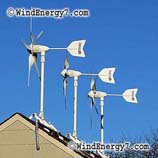Reconditioned Turbine, Remanufactured Wind Turbine
Tuesday, July 15th, 2008School wind projects and community wind projects are considered medium sized requirements. So, costs are important and quick return on investment more important.
For most of these wind projects that I am working on I am quoting and recommending remanufactured & refurbished turbines for wind farms.
The question of remanufactured turbines comes up in most every new wind power project. Using the reconditioned wind turbines, or remanufactured wind turbines, the cost to fund a project and get installation are much lower and therefore makes more sense. Frankly, it can be the difference in making a project make sense or not.
Normal Questions Asked Are:
(1) What’s difference n Remanufactured and Reconditioned Turbine?
(1) What is Projected Life of the Turbines being quoted/installed.
(2) Efficiency, we only work with best models, successful turbines.
(3) What are Operation and Maintenance Costs
(4) What is Installed Cost per Kilowatt
Reconditioned Turbine – a wind turbine where the condition of each of the main components are evaluated, then repaired or upgraded as needed. The turbines from WindEnergy7.com have been carefully de-installed in good working condition to make room for larger wind turbines. This creates a nice cost effective inventory of wind turbines for smaller school and community wind projects. These turbines can be reinstalled with minimal upgrade, depending on their condition and how long it’s been since they were de-installed. Our reconditioned turbines are available for reinstall and are already reconditioned when we sell them for a community wind project.
Remanufactured Turbines – The main moving components of these turbines have been re-manufactured to new or better than new standards, very thorough. The controls, gearbox, hub, generator, hydraulic system are all thoroughly remanufactured and restored. The most experienced turbine mechanics evaluate the condition of the remanufactured turbine. These turbines get delivered with a full technical reporting of the remanufacturing processes and as a result, they come with warranty periods.
Used Turbines – Sometimes referred to as raw turbines. This is a turbine sold in “as is” condition. I never recommend or get involved with the sale of a used, as-is turbine because of the risk involved. And I carefully advise anyone, before you buy any remanufactured or reconditioned wind turbines, please allow me and my suppliers to show you what we can do, competitively before you buy reconditioned or remanufactured trbines anywhere.
Cost of remanufactured and reconditioned turbines can vary. Again, please allow WindEnergy7.com to help you out here. We really prefer to quote these as fully Installed cost. This is better so we can be sure you are happy in the end. The installed cost includes the foundation, tower, turbine, electrical interface, wiring, engineering, program management and all components necessary to make the turbine a functioning/generating unit. We will be glad to work with whatever team you have in place, but if you haven’t aligned all these services, let us help.
Remanufactured/Reconditioned Wind Turbines vs. New:
Remanufactured turbine cost for 40kW to 600kW class turbine, usually in range of $1,000 per kW.
Cost of New turbines in this size/class, 40kW to 600kW, usually in the range of $1,700 per kW.
Compare to Utility sized new turbines, sizes from 1,500 kW to 3,500 kW = around $3,800 kW.
At a dramatically lower cost than the new turbine, the ROI (return on investment) of our remanufactured/reconditioned wind turbines is SO MUCH FASTER . So, your project is simply more successful as a financial endeavor, repaying loan costs at a quicker pace.
With ability to provide same warranty and have the remanufacturing or refurbishing done by the best mechanics and most experienced people i this industry, your ongoing operation and maintenance costs will be similar.
Supply & Demand – If you have a project, or a proposed project, please email me immediately and begin discussion. The new turbine supply is overloaded right now. There are many manufacturers with contracts that cannot be fulfilled for a couple of years out. Due to number of current projects, we do prefer email comminication is best, contact us at:
If you are interested in starting a wind project for your residence or acreage, contact us. To Buy a Wind Turbine or Become a Dealer, Please fill out our Contact Form. The system will automatically send you some additional info.







